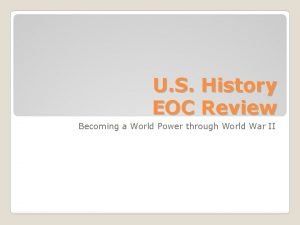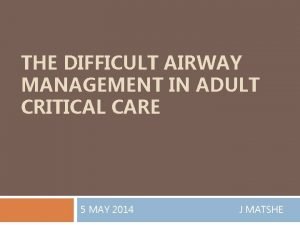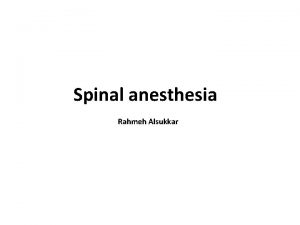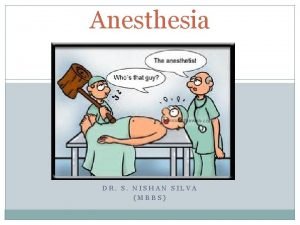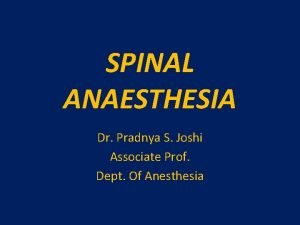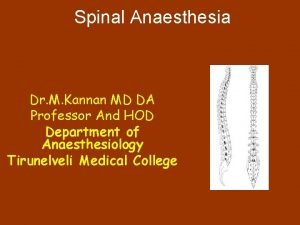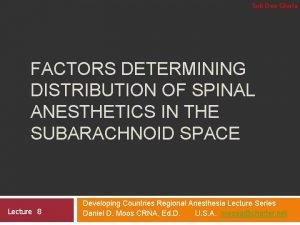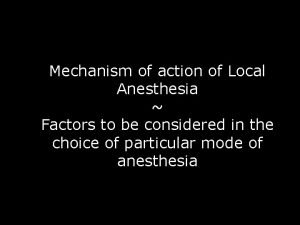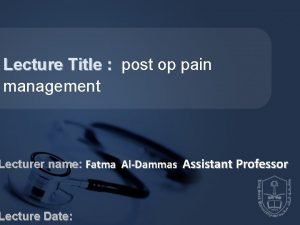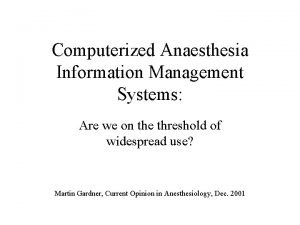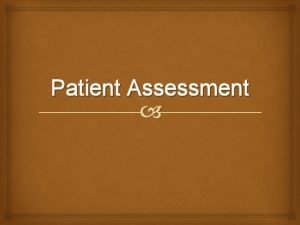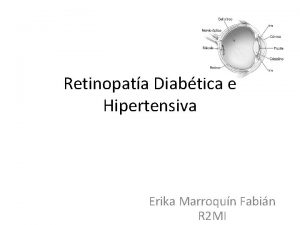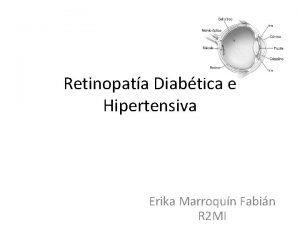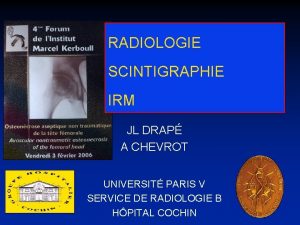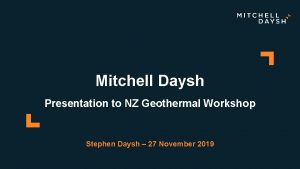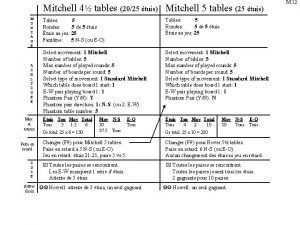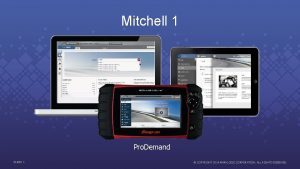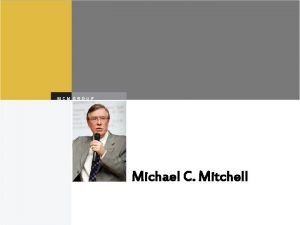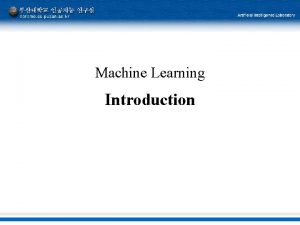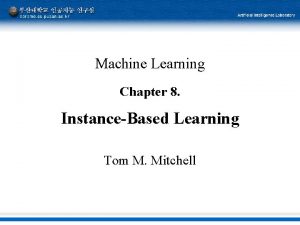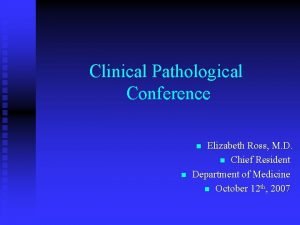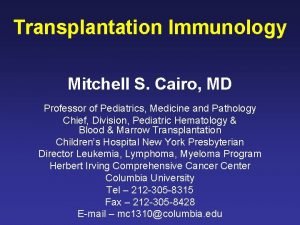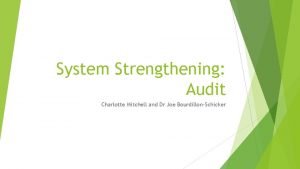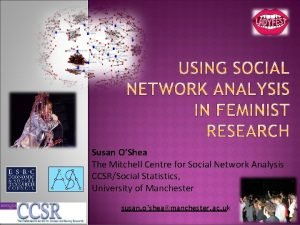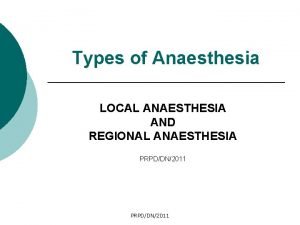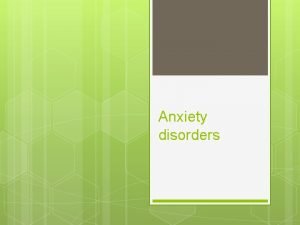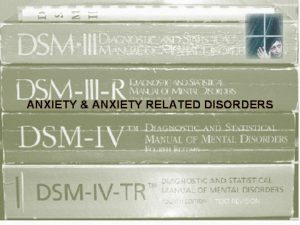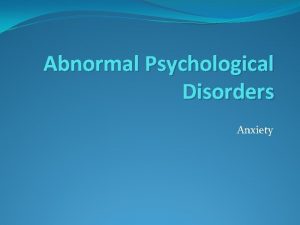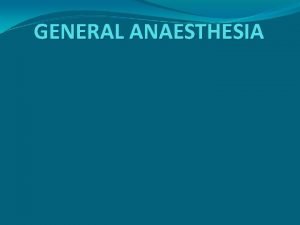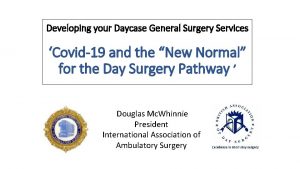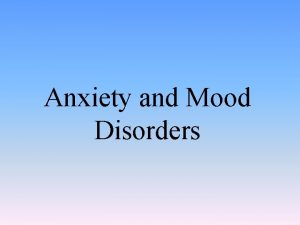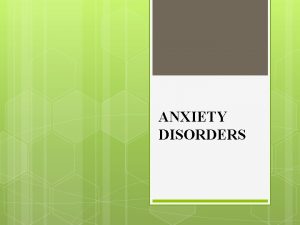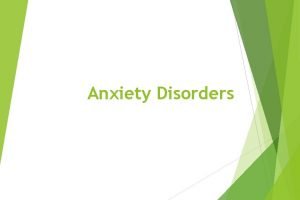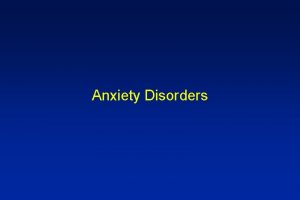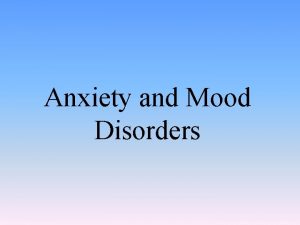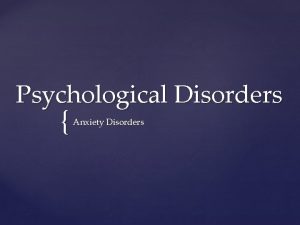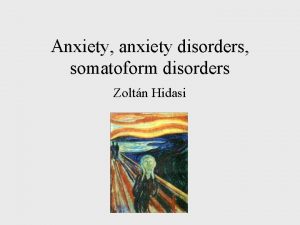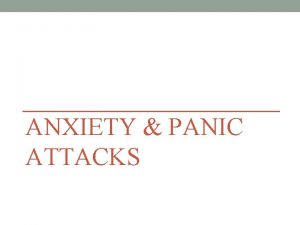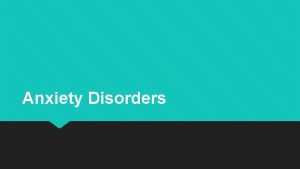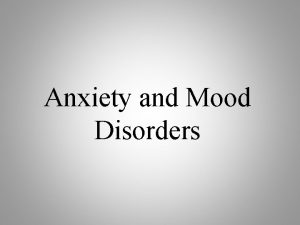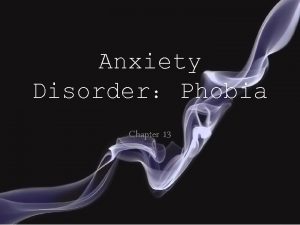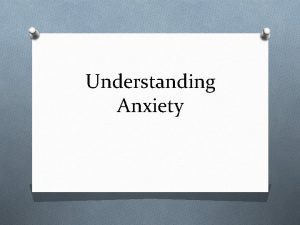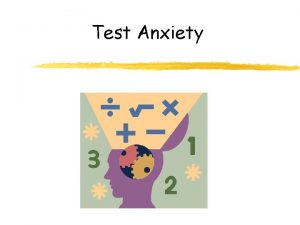General Anaesthesia Daycase Patient Anxiety Dr Mark Mitchell








































- Slides: 40

General Anaesthesia & Day-case Patient Anxiety Dr. Mark Mitchell College of Health and Social Care University of Salford Greater Manchester m. mitchell@salford. ac. uk +44 (0)161 -295 -6480

Cutting people open is no longer the focus of modern elective surgery. Planned and emergency surgery must be separate. An increase in day surgery is crucial not only for saving money but also patients recover quicker. "In recent years we have seen the biggest changes to surgical practice since its inception as a medical and scientific discipline in the nineteenth century. ” Darzi (2007) Saws & Scalpels to Lasers & Robots - Advances in Surg. London: Do. H (p. 6). We are therefore witnessing some of the greatest changes to surgical practice in 200 years.

Historically and certainly in the 20 th Century patients remained in a hospital bed for many days during the post-operative period. They could also remain in hospital for many weeks. c 1930’s

Everything needed to care taken to the bedside as considerable. Knowledge correct trolley for various nursing’s priorities. for the patient had to be physical incapacity was and preparation of the procedures was high on Watson (1979) Medical-Surgical Nursing and Related Physiology Saunders, London. c 1960’s

c 1960’s

Physical aspects of care, such as wound dressing, pain management, comfort, hygiene general and specific post-operative care consumed much nursing time and intervention. Pearce (1975) A General Textbook of Nursing: A Compendium of Nursing Knowledge. Faber and Faber, London. As a result of the ensuing patient incapacity, the organisation and delivery of physical aspects of care dominated. The model of nursing by Roper, Logan & Tierney with a central focus upon the Activities of Daily Living (1980) was therefore highly appropriate. Roper, Logan & Tierney (1980) Elements of Nurs: A model for nurisng based on model living. Churchill-Livingston: London. c 1980’s

In the past – Considerable amount of physical care Very busy operating schedules Poorly, immobile, bed-bound patients Not always conscious upon return from theatre Occasionally, airway insitu In the 21 st Century, the medical practices that generated the need for such nursing intervention are in rapid decline. Surgical nursing is therefore having to adapt accordingly.

The modern day surgery patient walks into the Unit a few hours prior to surgery, goes to theatre and on return recovery is quick with many patients only requiring limited physical nursing intervention. Kingdon & Newman (2006) Determining pt discharge in an OP surg. Setting. AORNJ. 83(4) 898. Such a transformation in surgical practice is providing the opportunity for a much-needed change in emphasis for peri-operative nursing. Gilmartin (2007) Contemporary DS: Pt experience of discharge and recovery. Jour Clin Nurs. 16(6) 1117. A number of studies, spanning many years, have consistently reported much patient anxiety prior to elective day surgery. Mitchell (2007) Nurs. Research DS: A Lit. Rev Amb. Surg. 13(4) 1. Mottram (2009) Therapeutic rels in DS. Jour Clin Nurs. 18(20) 2830.

Many patients are reported to require an increased level of peri-operative psychological support due to the strange environment, unknown personnel, limited understanding of planned event and little time to adjust. Stomberg et al (2008) Clinical pract. & routines for DS in Sweden: improved nurs. interven. Jour Peri. Anesth Prac. 23(5) 311. With the demise of many physical aspects of care, the opportunity in which to provide more formal interventions of this nature may be emerging. Tse & So (2008) Nurs. perception peri-op teaching amb. Surg. pts. Jour Adv Nurs. 63(6) 619. 75% of all elective surgery to be undertaken on a day case basis by 2010 (64%). BADS - 80% possible. Do. H (2006) Deliver qual & value: Productivity & efficiency. London: Inst Inno & Improve. Additionally, extra ~10% 23 hour stay. Increase in Enhanced Recovery for major surgery.

RESEARCH QUESTION What features of the doctors' and nurses' verbal and non-verbal behaviour, the environment and anaesthesia impact on pre-operative anxiety prior to adult elective day surgery? METHODOLOGY Two questionnaires were constructed – one for G. A patients and one for L. A. / R. A. patients. Approximately 60 items were contained within each questionnaire. The items related directly to the research question i. e. doctors’ and nurses’ behaviours, the environment and the anaesthetic.

METHODOLOGY - cont The questionnaires were distributed in three dedicated Day Surgery Units within Greater Manchester, England (2005 – 2007) for return by post 24 – 48 hours later. RESULTS The four themes of anxiety and information provision, doctors’ and nurses’ behaviours, environment and general anaesthesia will be examined in order.

1) Anxiety and Information Provision n = 460 G. A. questionnaires were completed. 50% (n=229) of patients desired a detailed level of information. The majority of patients (87% n=403) wanted this information 1 – 4 weeks in advance of surgery. In comparison with LA patients, GA patients desired a greater amount of information.

Level of written information required? (n=460) (50%)

Preferred to receive written information? (n=460) (87%)

85% of G. A. patients stated they were anxious (extremely anxious through to quite anxious). The most anxiety provoking aspects were the wait 59% (n=270), the anaesthetic 41% (n=190), pain and discomfort 32% (n=149) and the operation 30% (n=140). In the majority of studies, prior to the rise in day surgery, anxiety associated with waiting did not present as an issue. Previously it was just the anaesthetic, pain/ discomfort and the operation.

Overall anxiety on the day of surgery (n=460) (85%)

What aspects were anxiety provoking? (n=460)

Patients were also asked “Did you consider NOT attending today and if so what was the reason”. The vast majority did not consider non-attendance although 19% (n=86) DID consider not attending with the largest proportion 11% (n=48) because of anxiety on the day. As these were patients who clearly DID attend the question remains how many DNA’s may result from anxiety?

2) Doctors’ and Nurses’ Behaviours Here the focus was mainly on the words or phrases potentially employed to aid patients’ cognitive coping strategies “you will be safe because…” as very little work has been undertaken in this area. Firstly, 69% (n=315) of patients stated explanations by the nurses would make them either very calm or a little calm. Being informed the “Hospital carries out many operations safely each day” was preferred by 52% (n=240). Being informed “All doctors and nurses are very experienced” was preferred by 61% (n=278).

What would be the effect on your anxiety if the doctors and nurses appeared calm? (n=460) (83%)

What would be the effect on your anxiety if informed “The chance of the anaesthetic not working properly is very rare”? (n=460) (48% did not want)

3) Environment 34% (n=154) stated it would be calming to read information concerning their operation on the day of surgery. 71% (n=326) stated having a partner/ friend with them while waiting would aid their anxiety. 70% (n=319) stated a modern looking ward would help reduce their anxiety. During the pre-operative wait, females significantly preferred greater social interaction and a greater desire for the presence of a relative/ friend than males.

3) Environment - cont During the pre-operative wait, males significantly preferred to read information about their surgery, listen to music or read a book in a modern looking environment compared to females.

How would listening to music or reading a magazine while waiting influence your anxiety? (n=460) (74%)

How would talking to a nurse while waiting influence your anxiety? (n=460) (72%)

4) General Anaesthesia 77% (n=356) stated it would be calming to have a visit from their anaesthetist prior to going to theatre. 78% (n=357) also stated it would help to reduce anxiety if their anaesthetist explained a little about their anaesthetic. The thought of dying during anaesthesia was anxiety provoking for 48% (n=222) of patients, not waking up 48% (n=220), waking during 45% (n=209), trusting strangers 42% (n=192) and having injections 38% (n=173).

Anxiety and general anaesthesia (n=460)

Finally, all items specifically relating to pre-operative anxiety were entered into a further statistical test named ‘Factor Analysis’. This test examines associations or groupings. In plain terms - Amazon (online bookstore) frequently states “people who bought this book also bought this book”. So they group you by association. Subsequent associations or groupings developed from patients ALL experiencing increased anxiety were -

1) Pre-operative Anaesthetic Information Need for information. Issues concerning induction of GA - mask over the face, length of anaesthesia, needles and trusting strangers. 2) Anaesthetic Catastrophising Anxiety regarding intra-operative management - dying while anaesthetised, not waking up afterwards (remaining in a coma) or waking up during surgery, etc. . 3) Imminence of Surgery Waiting their turn for theatre. Arriving in theatre, seeing medical equipment. Together these themes could explain 30% of the variance in ratings of anxiety on the day of surgery. In more simple terms -

If this Pie chart were to represent the total amount of patient anxiety on the day of surgery 30% of anxiety can be explained by the issues associated here with – Pre-operative Anaesthetic Information ANXIETY Anaesthetic Catastrophising Imminence of Surgery

CLINICAL RECOMENDATIONS 1) Pre-operative Anaesthetic Information The majority of patients desire much information 1 - 4 weeks in advance of their surgery. Provision of the desired level and amount of anaesthetic information required prior to the day of surgery. The day of surgery is too late for the majority of patients. Inclusion of such issues within Integrated Care Pathways have been suggested as a method of ensuring the delivery of psychological aspects care. Mitchell (2000) Psycho prep for patients undergoing day surgery. Amb Surg. 8(1) 19. Timmins & Mc. Cabe (2009) Day Surgery: Contemp. Approach Nurs. Care Wiley-Blackwell: UK.

2) Anaesthetic Catastrophising Misconceptions regarding anaesthesia together with other aspect of information are required 1 - 4 weeks in advance of surgery. Catastrophising thoughts such as dying under anaesthesia, not waking afterwards (remaining in a coma) and waking up during surgery can be common. All such thoughts can be eased with brief explanations. Payne et al. (2003) Anaesthesia for day case surg: A survey UK adult practice. Euro Jour Anaesthesio. 20(4) 311.

2) Anaesthetic Catastrophising - cont "Anaesthesia is a state of carefully controlled and supervised unconsciousness which allows surgery to be performed painlessly. . . " Lack et al (2003) Raising the Standard: Info. for patients. RCo. A and AAGBI, London (p. 67) Patient-centred anaesthetic information provision for the effective management of anxiety cannot be underestimated. Lack et al (2003) Raising the Standard: Info. for patients. RCo. A and AAGBI, London. Kindness, information from anaesthetist and feeling safe are most strongly related to satisfaction with anaesthesia. Capuzzo et al (2005) Emotional and interpers. factors for satisfaction with GA. Acta Anaesthesiol Scand. 49(6) 735.

3) Imminence of Surgery Interpersonal skills of the anaesthetist and nurse can be of great value in limiting anxiety. van der Zee et al (2002) Influence of premed consult and prep. info on anxiety patients for cardiac surg. Anxiety, Stress & Coping. 15(2) 123. Aspects determined also to be of benefit are close physical support, words of encouragement and methods of distraction. Kaldenberg & Becker (1999) Eval. care by amb. surg patients. Health Care Man. Review. 24(3) 73. Pearson et al (2004) Best pract DS: Review of evid. Amb. Surg. 11(1 -2) 49.

3) Imminence of Surgery - cont Pre-operatively, females had a preference for greater social interaction and a greater desire for the presence of a relative/ friend. Pre-operatively, males preferred to read information about their surgery to help reduce anxiety, listen to music or read a book all in a modern looking environment. While all units vary, staggered admission times and the presence of relatives are options (controversial). Manners et al (2010) Utilising "theme" day surgery improve efficiency reduce costs. Jour. One Day Surg. 20(1) 17.

CONCLUSION Nursing must clearly always be guided by medical innovation but we are also obligated to enhance such innovation and not to be merely instructed by it. If ‘Integrated Care Pathways’ are to become the clinically accepted norm for care delivery in rapid care surgical settings, then ‘nursing knowledge’ must gain a strong place in such documentation.

CONCLUSION - cont Others have made similar suggestions for pre-operative assessment, that is, nursing should endeavour not to replicate medical information but concentrate on delivering care synonymous with the nursing role (pre/ post-operative care, support, information provision, recovery activities, dietary advice and management of common complications). Blay and Donoghue (2006) Source and content of health info for pts undergoing lap choles. Int Jour Nurs Pract. 12(2) 64.

Finally, it is impossible to completely eradicate all patient anxiety during the brief episodes of hospitalisation and limited contact with unfamiliar patients. However, more taught, planned, deliberate attempts to manage anxiety more effectively must become a central feature of modern surgical practices and occupy the ground vacated by the once dominant physical intervention approach to surgical nursing care.

Intervention Pre-operative Information 1 - 4 weeks in advance for majority. Detailed level of information for majority. Both surgical and anaesthetic information. Planned approach formally documented. Anaesthetic Catastrophising Erroneous and unhelpful thoughts regarding anaesthesia explored in advance. Emphasis on “carefully controlled and supervised unconsciousness”. Emphasize close monitoring and presence of anaesthetist and nurse during surgery. Imminence of Surgery Close physical support, physical contact (if desired) and words of encouragement. Simple methods of distraction. Close support from a relative/ friend where possible, consider staggered admission times.

FURTHER READING Haugen et al (2009) Anx in operating theatre. Jour Clin Nurs. 18(16) 2301 2310. Johnson et al (2012) Peri-op music decreases anx. Jour Peri. Anesth Nurs. 27(3) 146 - 154. Mitchell (2008) Conscious surg: Influence of environ on pt anxiety. Jour Adv Nurs. 64(3) 261 - 271. Mitchell (2009) Pt anxiety & conscious surg. Jour Peri-op Pract. 19(6) 168 - 173. Mitchell (2010) GA and day-case pt anx. Jour Adv Nurs. 66(5) 1059 - 1071. Mitchell (2012) Influence of gender & anaesth day surg anx. Nurs. 68(5) 1014 - 1025. Jour Adv Mitchell (2012) Anxiety man in adult minimal stay surg. Nurs Times. 68(5) 1014 - 1025. Nilsson (2008) Anxiety and pain-reducing effects music: A review. AORNJ. 87(4) 780 - 794.
 World power era eoc blitz review
World power era eoc blitz review Thyromental distance fingers
Thyromental distance fingers Head tilt chin lift
Head tilt chin lift Spinal anaesthesia structures pierced
Spinal anaesthesia structures pierced Paramedian epidural layers
Paramedian epidural layers Balanced anesthesia components
Balanced anesthesia components Components of anaesthesia
Components of anaesthesia Dr pradnya joshi
Dr pradnya joshi Spinal anaesthesia structures pierced
Spinal anaesthesia structures pierced Contraindications of spinal anaesthesia
Contraindications of spinal anaesthesia Calcium displacement theory of local anaesthesia
Calcium displacement theory of local anaesthesia Mechanism of local anesthesia
Mechanism of local anesthesia Blood patch procedure
Blood patch procedure Balanced anaesthesia ppt
Balanced anaesthesia ppt Anaesthesia information management system
Anaesthesia information management system Patient 2 patient
Patient 2 patient General history taking of patient
General history taking of patient Turbine banki cross-flow®
Turbine banki cross-flow® Nickole mitchell
Nickole mitchell Basil mitchell
Basil mitchell Mitchell1 social crm
Mitchell1 social crm Retinopatia diabetica clasificacion
Retinopatia diabetica clasificacion Retinopata
Retinopata Classification de mitchell ostéonécrose
Classification de mitchell ostéonécrose Mitchell daysh
Mitchell daysh 4 table mitchell movement
4 table mitchell movement Mitchell on demand pro
Mitchell on demand pro Michael c mitchell
Michael c mitchell Machine learning by tom mitchell
Machine learning by tom mitchell Machine learning tom
Machine learning tom Christina tripodi mitchell
Christina tripodi mitchell Mitchell merritt algorithm
Mitchell merritt algorithm Dr mitchell charap
Dr mitchell charap Emmett mitchell engineering
Emmett mitchell engineering Mitchell cheeseman
Mitchell cheeseman Mitchell cairo md
Mitchell cairo md Mitchell sanders the things they carried
Mitchell sanders the things they carried Stephen mitchell md
Stephen mitchell md Dr charlotte mitchell
Dr charlotte mitchell Dr susan o shea
Dr susan o shea Mitchell lipton md
Mitchell lipton md
